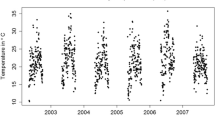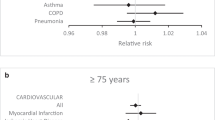Abstract
Although the impact of temperature on mortality is well documented, relatively fewer studies have evaluated the associations of temperature with morbidity outcomes such as hospital admissions, and most studies were conducted in North America or Europe. We evaluated weather and hospital admissions including specific causes (allergic disease, asthma, selected respiratory disease, and cardiovascular disease) in eight major cities in Korea from 2003 to 2008. We also explored potential effect modification by individual characteristics such as sex and age. We used hierarchical modeling to first estimate city-specific associations between heat, cold, or heat waves and hospitalizations, and then estimated overall effects. Stratified analyses were performed by cause of hospitalization, sex, and age (0–14, 15–64, 65–74, and ≥75 years). Cardiovascular hospitalizations were significantly associated with high temperature, whereas hospitalizations for allergic disease, asthma, and selected respiratory disease were significantly associated with low temperature. The overall heat effect for cardiovascular hospitalization was a 4.5 % (95 % confidence interval 0.7, 8.5 %) increase in risk comparing hospitalizations at 25 to 15 °C. For cold effect, the overall increase in risk of hospitalizations comparing 2 with 15 °C was 50.5 (13.7, 99.2 %), 43.6 (8.9, 89.5 %), and 53.6 % (9.8, 114.9 %) for allergic disease, asthma, and selected respiratory disease, respectively. We did not find statistically significant effects of heat waves compared with nonheat wave days. Our results suggest susceptible populations such as women and younger persons. Our findings provide suggestive evidence that both high and low ambient temperatures are associated with the risk of hospital admissions, particularly in women or younger person, in Korea.


Similar content being viewed by others
References
Anderson BG, Bell ML (2009) Weather-related mortality: how heat, cold, and heat waves affect mortality in the United States. Epidemiology 20:205–213
Anderson BG, Bell ML (2011) Heat waves in the United States: mortality risk during heat waves and effect modification by heat wave characteristic in 43 U.S. communities. Environ Health Perspect 119(2):210–218
Barnett AG, Dobson AJ, McElduff P, Salomaa V, Kuulasmaa K, Sans S (2005) Cold periods and coronary events: an analysis of populations worldwide. J Epidemiol Community Health 59:551–557
Basu R, Ostro BD (2008) A multicounty analysis identifying the populations vulnerable to mortality associated with high ambient temperature in California. Am J Epidemiol 168(6):632–637
Basu R, Pearson D, Malig B, Broadwin R, Green R (2012) The effect of high ambient temperature on emergency room visits. Epidemiology 23(6):813–820
Bell ML, O’Neill MS, Ranjit N, Borja-Aburto VH, Cifuentes LA, Gouveia NC (2008) Vulnerability to heat-related mortality in Latin America: a case-crossover study in Sao Paulo, Brazil, Santiago, Chile and Mexico City, Mexico. Int J Epidemiol 37:796–804
Braga AL, Zanobetti A, Schwartz J (2001) The time course of weather-related deaths. Epidemiology 12(6):662–667
Canouï-Poitrine F, Cadot E, Spira A, Groupe régional Canicule (2003) Excess deaths during the August 2003 heat wave in Paris France. Rev Epidemiol Sante Publique 54:127–133
Curriero FC, Heiner KS, Samet JM, Zeger SL, Strug L, Patz JA (2002) Temperature and mortality in 11 cities of the Eastern United States. Am J Epidemiol 155:80–87
Dawson J, Weir C, Wright F, Bryden C, Aslanyan S, Lees K et al (2008) Associations between meteorological variables and acute stroke hospital admissions in the west of Scotland. Acta Neurol Scand 117:85–89
Ebi KL, Exuzides KA, Lau E, Kelsh M, Barnston A (2004) Weather changes associated with hospitalizations for cardiovascular disease and stroke in California, 1983–1998. Int J Biometeorol 49:48–58
Everson P (2000) Two-level normal independent sampling estimation (TLNise). Swarthmore College, Swarthmore
Gasparrini A, Armstrong B (2011) The impact of heat waves on mortality. Epidemiology 22:68–73
Green RS, Basu R, Malig B, Broadwin R, Kim JJ, Ostro B (2010) The effect of temperature on hospital admissions in nine California counties. Int J Public Health 55:113–121
Ha J, Yoon J, Kim H (2009) Relationship between winter temperature and mortality in Seoul, South Korea, from 1994 to 2006. Sci Total Environ 407:2158–2164
Ha J, Kim H, Hajat S (2011) Effect of previous-winter mortality on the association between summer temperature and mortality in South Korea. Environ Health Perspect 119:542–546
Haines A, Kovats RS, Campbell-Lendrum D, Corvalan C (2006) Climate change and human health: impacts, vulnerability, and mitigation. Lancet 367:2101–2109
Hajat S, Haines A (2002) Associations of cold temperatures with GP consultations for respiratory and cardiovascular disease among the elderly in London. Int J Epidemiol 31:826–830
Hajat S, Kosatky T (2010) Heat-related mortality: a review and exploration of heterogeneity. J Epidemiol Community Health 64:753–760
Hajat S, Armstrong BG, Gouveia N, Wilkinson P (2005) Mortality displacement of heat-related deaths. Epidemiology 16:613–620
Hajat S, Armstrong B, Baccini M, Biggeri A, Bisanti L, Russo A, Paldy A, Menne B, Kosatsky T (2006) Impact of high temperatures on mortality: is there an added heat wave effect? Epidemiology 17:632–638
Hong YC, Rha JH, Lee JT, Ha EH, Kwon HJ, Kim H (2003) Ischemic stroke associated with decrease in temperature. Epidemiology 14:473–478
Keatinge WR, Coleshaw S, Easton J, Cotter F, Mattock M, Chelliah R (1986) Increased platelet and red cell counts, blood viscosity, and plasma cholesterol levels during heat stress, and mortality from coronary and cerebral thrombosis. Am J Med 81:795–800
Kim H, Ha J, Park J (2006) High temperature, heat index, and mortality in 6 major cities in South Korea. Arch Environ Occup Health 61:265–270
Knowlton K, Rotkin-Ellman M, King G, Margolis HG, Smith D, Solomon G et al (2009) The 2006 California heat wave: impacts on hospitalizations and emergency department visits. Environ Health Perspect 117(1):61–67
Koken PJ, Piver WT, Ye F, Elixhauser A, Olsen LM, Portier CJ (2003) Temperature, air pollution, and hospitalization for cardiovascular diseases among elderly people in Denver. Environ Health Perspect 111:1312–1317
Kovats RS, Hajat S, Wilkinson P (2004) Contrasting patterns of mortality and hospital admissions during hot weather and heat waves in Greater London, UK. Occup Environ Med 61:893–898
Liang WM, Liu WP, Chou SY, Kuo HW (2008) Ambient temperature and emergency room admissions for acute coronary syndrome in Taiwan. Int J Biometeorol 52(3):223–229
Liang WM, Liu WP, Kuo HW (2009) Diurnal temperature range and emergency room admissions for chronic obstructive pulmonary disease in Taiwan. Int J Biometeorol 53(1):17–23
Lim YH, Hong YC, Kim H (2012) Effects of diurnal temperature range on cardiovascular and respiratory hospital admissions in Korea. Sci Total Environ 417–418:55–60
Lin HC, Lin CC, Chen CS, Lin HC (2009a) Seasonality of pneumonia admissions and its association with climate: an eight-year nationwide population-based study. Chronobiol Int 26(8):1647–1659
Lin S, Luo M, Walker RJ, Liu X, Hwang SA, Chinery R (2009b) Extreme high temperatures and hospital admissions for respiratory and cardiovascular disease. Epidemiology 20:738–746
Linares C, Diaz J (2008) Impact of high temperatures on hospital admissions: comparative analysis with previous studies about mortality (Madrid). Eur J Public Health 18:317–322
Ma W, Xu X, Peng L, Kan H (2011) Impact of extreme temperature on hospital admission in Shanghai, China. Sci Total Environ 409:3634–3637
Medina-Ramon M, Zanobetti A, Cavanagh DP, Schwartz J (2006) Extreme temperatures and mortality: assessing effect modification by personal characteristics and specific cause of death in a multi-city case-only analysis. Environ Health Perspect 114:1331–1336
Mercer JB (2003) Cold-an underrated risk factor for health. Environ Res 92:8–13
Michelozzi P, De Sario M, Accetta G, de’Donato F, Kirchmayer U, D’Ovidio M, Perucci CA, HHWWS Collaborative Group (2006) Temperature and summer mortality: geographical and temporal variations in four Italian cities. J Epidemiol Community Health 60:417–423
Michelozzi P, Accetta G, De Sario M, D’lppoliti D, Marino C, Baccini M et al (2009) High temperature and hospitalizations for cardiovascular and respiratory causes in 12 European cities. Am J Respir Crit Care Med 179:383–389
O’Neill MS, Zanobetti A, Schwartz J (2003) Modifiers of the temperature and mortality association in seven US cities. Am J Epidemiol 157:1074–1082
O’Neill MS, Zanobetti A, Schwartz J (2005) Disparities by race in heat-related mortality in four US cities: the role of air conditioning prevalence. J Urban Health 82(2):191–197
Ostro B, Rauch S, Green R, Malig B, Basu R (2010) The effects of temperature and use of air conditioning on hospitalizations. Am J Epidemiol 72:1053–1061
Peng RD, Bobb JF, Tebaldi C, McDaniel L, Bell ML, Dominici F (2011) Toward a quantitative estimate of future heat wave mortality under global climate change. Environ Health Perspect 119:701–706
Poumadère M, Mayes C, Le Mer S, Blong R (2005) The 2003 heat wave in France: dangerous climate change here and now. Risk Anal 25:1483–1494
Pudpong N, Hajat S (2011) High temperature effects on out-patient visits and hospital admissions in Chiang Mai, Thailand. Sci Total Environ 409(24):5260–5267
Reid CE, Snowden JM, Kontgis C, Tager IB (2012) The role of ambient ozone in epidemiologic studies of heat-related mortality. Environ Health Perspect 120:1627–1630
Ren C, Williams GM, Tong S (2006) Does particulate matter modify the association between temperature and cardiorespiratory diseases? Environ Health Perspect 114:1690–1696
Schwartz J, Samet JM, Patz JA (2004) Hospital admissions for heart disease: the effects of temperature and humidity. Epidemiology 15:755–761
Son JY, Lee JT, Anderson GB, Bell ML (2011) Vulnerability to temperature-related mortality in Seoul, Korea. Environ Res Lett 6:034027
Son JY, Lee JT, Anderson GB, Bell ML (2012) The impact of heat waves on mortality in seven major cities in Korea. Environ Health Perspect 120:566–571
Son JY, Lee JT, Park YH, Bell ML (2013) Short-term effects of air pollution on hospital admissions in 8 cities in Korea, 2003-2008. Epidemiology 24(4):545–554
Wichmann J, Andersen Z, Ketzel M, Ellermann T, Loft S (2011) Apparent temperature and cause-specific emergency hospital admissions in Greater Copenhagen, Denmark. PLoS ONE 6(7):e22904. doi:10.1371/journal.pone.0022904
Wichmann J, Ketzel M, Ellermann T, Loft S (2012) Apparent temperature and acute myocardial infarction hospital admissions in Copenhagen, Denmark: a case-crossover study. Environ Health 11:19
Ye F, Piver WT, Ando M, Portier CJ (2001) Effects of temperature and air pollutants on cardiovascular and respiratory diseases for males and females older than 65 years of age in Tokyo, July and August 1980–1995. Environ Health Perspect 109:355–359
Yi O, Hong YC, Kim H (2010) Seasonal effect of PM10 concentrations on mortality and morbidity in Seoul, Korea: a temperature-matched case-crossover analysis. Environ Res 110:89–95
Yu W, Vaneckova P, Mengersen K, Pan X, Tong S (2010) Is the association between temperature and mortality modified by age, gender, and socio-economic status? Sci Total Environ 408:3513–3518
Acknowledgments
The authors thank Korea Centers for Disease Control and Prevention, National Health Insurance Corporation for providing health insurance data.
Conflict of Interest
The authors declare that they have no conflicts of interest.
Author information
Authors and Affiliations
Corresponding author
Electronic supplementary material
Below is the link to the electronic supplementary material.
ESM 1
(DOCX 143 kb)
Rights and permissions
About this article
Cite this article
Son, JY., Bell, M.L. & Lee, JT. The impact of heat, cold, and heat waves on hospital admissions in eight cities in Korea. Int J Biometeorol 58, 1893–1903 (2014). https://doi.org/10.1007/s00484-014-0791-y
Received:
Revised:
Accepted:
Published:
Issue Date:
DOI: https://doi.org/10.1007/s00484-014-0791-y




